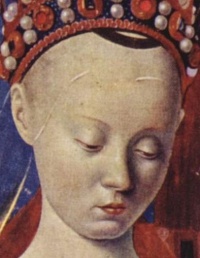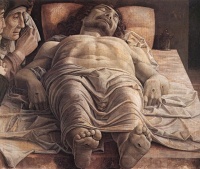15th century
From The Art and Popular Culture Encyclopedia
| Revision as of 17:47, 20 May 2019 Jahsonic (Talk | contribs) ← Previous diff |
Revision as of 17:47, 20 May 2019 Jahsonic (Talk | contribs) Next diff → |
||
| Line 16: | Line 16: | ||
| The fall of Constantinople led to the migration of [[Greek scholars in the Renaissance|Greek scholars]] and texts to Italy, while [[Johannes Gutenberg]]'s invention of the mechanical [[movable type]] began the [[Printing Press]]. These two events played key roles in the development of the [[Renaissance]]. | The fall of Constantinople led to the migration of [[Greek scholars in the Renaissance|Greek scholars]] and texts to Italy, while [[Johannes Gutenberg]]'s invention of the mechanical [[movable type]] began the [[Printing Press]]. These two events played key roles in the development of the [[Renaissance]]. | ||
| - | |||
| The Spanish [[Reconquista]] leads to the final fall of the [[Emirate of Granada]] by the end of the century, ending over seven centuries of Muslim rule and returning Spain back to Christian rulers. | The Spanish [[Reconquista]] leads to the final fall of the [[Emirate of Granada]] by the end of the century, ending over seven centuries of Muslim rule and returning Spain back to Christian rulers. | ||
Revision as of 17:47, 20 May 2019

|
Related e |
|
Featured: |
The 15th century was the century which spans the Julian years 1401 to 1500.
In Europe, the 15th century is seen as the bridge between the Late Middle Ages, the Early Renaissance, and the Early modern period. Many technological, social and cultural developments of the 15th century can in retrospect be seen as heralding the "European miracle" of the following centuries. In religious history, the Roman Papacy was split in two parts in Europe for decades (the so-called Western Schism), until the Council of Constance. The division of the Catholic Church and the unrest associated with the Hussite movement would become factors in the rise of the Protestant Reformation in the following century.
Constantinople, in what is today Turkey, then the capital of the Christian Byzantine Empire, falls to the emerging Muslim Ottoman Turks, marking the end of the tremendously influential Byzantine Empire and, for some historians, the end of the Middle Ages. The event forced Western Europeans to find a new trade route, adding further momentum to what was the beginning of the Age of Discovery, which would lead to the global mapping of the world. Explorations by the Portuguese and Spanish led to European sightings of the Americas (the New World) and the sea passage along Cape of Good Hope to India, in the last decade of the century. These expeditions ushered in the era of the Portuguese and Spanish colonial empires.
The fall of Constantinople led to the migration of Greek scholars and texts to Italy, while Johannes Gutenberg's invention of the mechanical movable type began the Printing Press. These two events played key roles in the development of the Renaissance.
The Spanish Reconquista leads to the final fall of the Emirate of Granada by the end of the century, ending over seven centuries of Muslim rule and returning Spain back to Christian rulers.
The Hundred Years' War end with a decisive French victory over the English in the Battle of Castillon. Financial troubles in England following the conflict results in the Wars of the Roses, a series of dynastic wars for the throne of England. The conflicts end with the defeat of Richard III by Henry VII at the Battle of Bosworth Field, establishing the Tudor dynasty in the later part of the century.
In Asia, under the rule of the Yongle Emperor, who built the Forbidden City and commanded Zheng He to explore the world overseas, the Ming Dynasty's territory reached its pinnacle. Tamerlane established a major empire in the Middle East and Central Asia, in order to revive the Mongol Empire.
In Africa, the spread of Islam leads to the destruction of the Christian kingdoms of Nubia, by the end of the century leaving only Alodia (which was to collapse in 1504). The formerly vast Mali Empire teeters on the brink of collapse, under pressure from the rising Songhai Empire.
In the Americas, both the Inca Empire and the Aztec Empire reach the peak of their influence.
[[File:Pacioli.jpg|250px|thumb|upright|Portrait of the founder of accounting, Luca Pacioli, by Jacopo de' Barbari (Museo di Capodimonte).]]
Contents |
Trends
- Quattrocento
- Gothic art
- End of the Middle Ages
- Gilles de Rais
- rediscovery of Nero's Golden house
- early Renaissance
- Fashion in 15th century Europe
- Renaissance affects philosophy, science and art.
- Age of Discovery begins.
- Johannes Gutenberg invents the printing press in Europe (c. 1455).
- Linear perspective drawing perfected by Filippo Brunelleschi 1410-1415
- Europe Claims America October 12 1492, Christopher Columbus's expedition makes landfall in the Caribbean. The Italian explorer believes he has reached East Asia.
Culture
- Facetiae (1470) by Poggio
- The Birth of Venus (Botticelli), c. 1485
- Satyr mourning over a nymph (c. 1495) by Piero di Cosimo
- The Bonfire of the Vanities
- The use of tobacco is introduced into Europe by Columbus and his crew returning from America.
- 1431 - First German peasant revolt at Worms, Germany
- The Malleus Maleficarum (1486) Heinrich Kramer and James Sprenger
- Vlad the Impaler
- Vlad III Dracula (also known as Vlad Tepes in Romanian or Vlad the Impaler)
- 1485 The first edition Danse Macabre is published in Paris by Guyot Marchant
Births
- François Villon
- Hans Holbein
- Hieronymus Bosch
- Quentin Matsys
- Albrecht Dürer
- Matthias Grünewald
- Lucas Cranach
- Hans Baldung Grien
- Pietro Aretino
- François Rabelais
- Jean Fouquet, French painter.
- Gilles de Rais
- Michael Pacher
- Joan of Arc, national heroine of France (1412 - 1431).
- François Villon, French poet (c. 1431 - 1474).
- Leonardo da Vinci, inventor and painter (1452 - 1519).
Deaths
- Jan Hus, Bohemian religious thinker and reformer (c. 1369 - 1415).
- Johannes Gutenberg, European inventor of printing with movable type (c.1398 - 1468)
- Joan of Arc, national heroine of France (1412 - 1431).
- François Villon, French poet (c. 1431 - 1474).
Events
- 1429: Joan of Arc ends the Siege of Orléans and turns the tide of the Hundred Years' War.
- 1481: Spanish Inquisition begins.
- 1492: Jews expelled from Spain.
- 1492: Christopher Columbus founds Spain's first New World colony on Hispaniola.
- 1494: Spain and Portugal sign the Treaty of Tordesillas and agree to divide the World outside of Europe between themselves.
- 1494-1559: The Italian Wars lead to the downfall of the Italian city-states.
- 1497-1499: Vasco da Gama's first voyage from Europe to India and back.
See also
- 1400s || 1410s || 1420s || 1430s || 1440s || 1450s || 1460s || 1470s || 1480s || 1490s
- 15th century art



